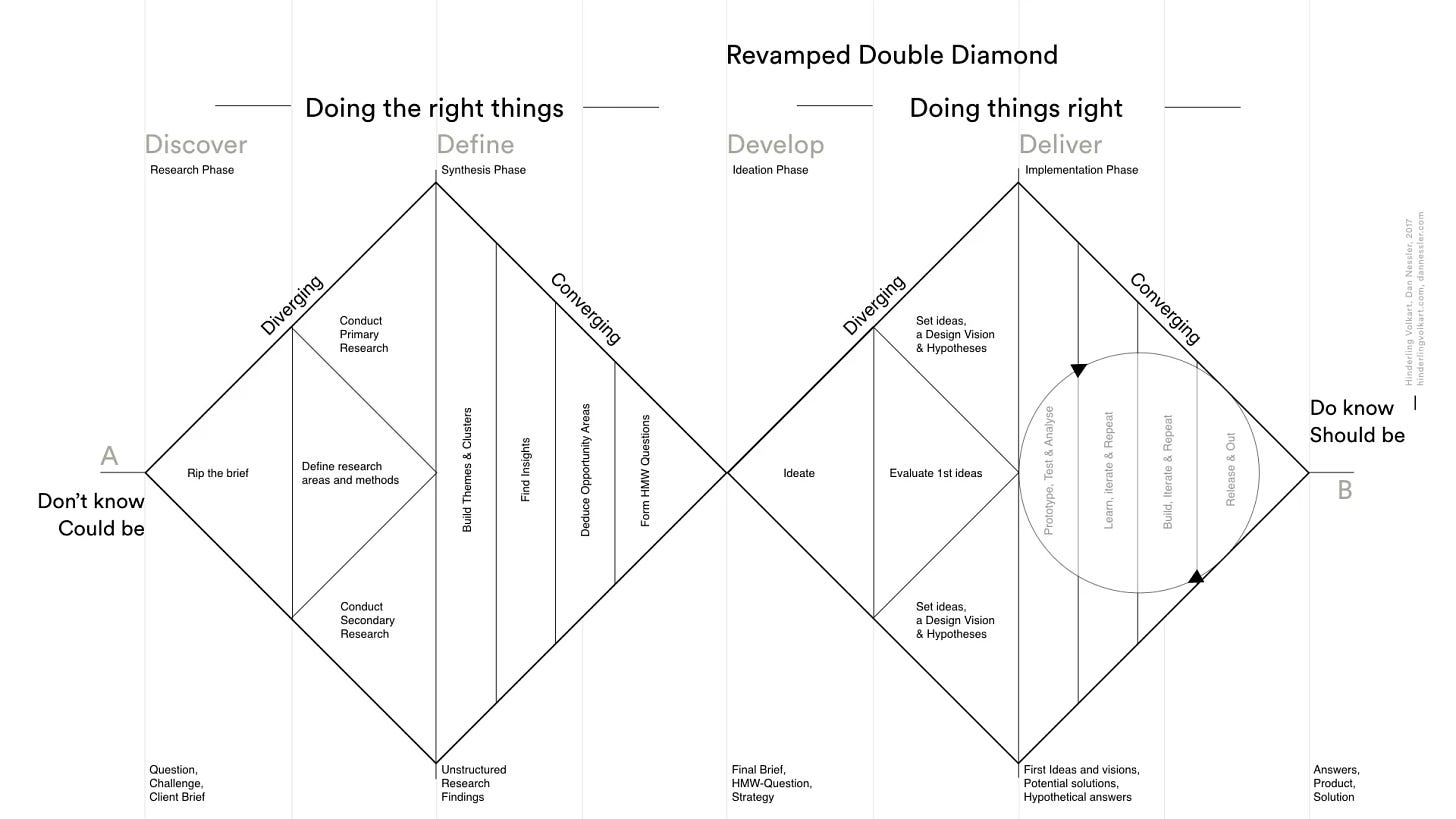The Beautiful Mess of Real-World Product Design
Beyond the Double Diamond: How to Thrive in the Messy World of Product Design.
Have you ever felt like design school didn't quite prepare you for the chaotic world of real product design? You're not alone. While frameworks, methodologies, and processes are great for learning the ropes, they often paint an unrealistic picture of a neat and tidy design process.
Remember the double diamond?

The truth is, 99% of what designers experience is messy. There's a relentless focus on design frameworks at the expense of what truly matters: design effectiveness, business impact, and standing out in a competitive market.
Sure, frameworks and processes act as guardrails when you're starting out. But real-world design is anything but linear. It's filled with ambiguity, unknowns, and constant iteration.

The designers that embrace this mess, and leverage the skills they have learned from the double diamond - adapt their design practice. Rather than looking at process as a step by step guide, they look at it as a collection of ingredients to put into a recipe. Unafraid to break the rules, challenge assumptions, and experiment. The focus is on outcomes over rigid processes.
Great designs come from a powerful blend:
Deep empathy for the user
Strong business acumen (check out my other article “whats the so what”)
Technical feasibility
Differentiation, challenging expectations
Learn the fundamentals, embrace best practices as you start, but be prepared to flex and adapt with your partners, and as needs of the business change. The most successful design teams are the ones who can navigate this ambiguity with creativity, data-driven insights, and a laser focus on delivering exceptional user experiences and driving business value.
Here are some practical tips to help you navigate the unknown:
Empathy (Even When Time is Tight): Conduct user interviews and usability tests whenever possible. If time is limited, prioritize user conversations and rapid usability testing with a small group of users.
Data Drives Decisions: Leverage analytics tools, parallel product knowledge and user research to gather data insights. Look across the landscape when information is limited, prioritize qualitative data like user interviews to understand user pain points and needs.
Navigate Risk with a Balanced Approach: Don't be afraid to experiment, but prioritize low-fidelity prototypes and A/B testing to mitigate risk before implementing major design changes.
Communication is Key: Clearly communicate your design decisions and rationale to stakeholders. Use visuals, data, and clear explanations to build buy-in for your ideas.
The Power of Iteration
The messy design process is all about iteration. Here's how to make the most of it:
Plan to Test and Learn: Develop a testing plan that outlines your goals, target users, and testing methods. This ensures you gather valuable user feedback throughout the design process.
Feedback is Your Friend: Actively solicit user feedback through interviews, surveys, and usability testing. Use this feedback to refine your designs and ensure they meet user needs.
Embracing the Beautiful Messiness
While a messy design process may seem daunting, it can also lead to some of the most innovative and user-centered solutions. By embracing the mess, you open yourself up to the possibility of:
Unforeseen Breakthroughs: Stepping outside the rigid confines of traditional design processes can lead to unexpected solutions that address user needs in entirely new ways.
A Deeper Understanding of Users: The iterative nature of messy design allows you to continuously gather user feedback and refine your designs, resulting in a product that truly resonates with your target audience.
Remember, the most beautiful designs often emerge from the beautiful mess. Embrace the unknown, focus on user needs and business goals, and you'll be well on your way to thriving in the exciting world of real-world product design.





Thank you for writing this amazing article! It truly reflects every design project's reality: there is never a perfect 'double diamond flow' in the real world. The value of a designer lies in how they overcome constraints during their work and deliver successful design solutions to the team. However, I still struggle with how to showcase 'The Beautiful Mess' in my portfolio pieces. How can I present the messiness of the project while still telling a compelling story in the end?